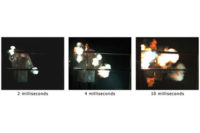It’s a legitimate question, because in the majority of non-FR clothing programs end-users do not select a specific brand of fabric. With non-FR uniforms, end-users simply rely on the advice of their garment manufacturer, distributor and/or laundry provider, or buy whatever is least expensive. In non-FR applications it makes sense to give the garment manufacturer the authority to investigate and select the type of fabric it uses to produce the garments. This is because the technology to weave and dye conventional fabrics is relatively straightforward and there are countless textile mills around the world capable of producing quality products.
Choose fabric first
Conversely, with FR clothing, end-users should take an active role in investigating and specifying the brand of FR fabric that will be used to produce the garments. Talk to the FR fabric manufacturer about the engineering technology used, testing and documentation procedures, and performance of the FR fabrics in the field, complete with end-user testimonials. In fact, Bill Mullen, field operations manager for a large electric utility and leader of the largest arc flash testing ever conducted by an end-user, says: “The FR fabric brand is the most important thing; all the testing we did showed you have to specify the fabric brand first, and then you can find the preferred garments and vendors.â€There are three critical reasons why selecting an FR fabric brand first is an industry best practice:
- The FR fabric dictates the level of protection the garment provides in an accident. The fabric also dictates most of the comfort and overall value equation.
- The most important component of the consensus standards for protective clothing are all based on FR fabric performance characteristics.
- All FR fabrics are engineered; the technology required to produce these fabrics is extremely complex.
Unfortunately, an accident is often the only time you find out whether the flame resistance is sufficient or if it has been compromised by laundering because the test used to determine flame resistance is destructive. To that point, Bill Mullen states, “We spent $4 million over almost four years testing FR clothing in arcs at the KEMA lab outside Philadelphia. We tested some generic FR fabrics, which went on fire, and we chose not to go that route.â€
Market-proven?
As the FR clothing market expands, end-users should be wary of poor quality FR fabrics that quickly lose flame resistance after washing. Also watch out for FR garments made with generic “house brands†of flame-resistant cotton and cotton blend fabrics. These off-brands are often offered with test reports showing compliance to industry standards, nice looking brochures and a “promise.†On the surface, this seemingly economical option could look attractive. However, it takes many years of extensive wear-trial evaluations, along with actual successful program installations to truly determine whether or not an unproven FR fabric is a good solution. It’s important to recognize that most of the problems highlighted herein would not be uncovered when testing to industry standards. Therefore, although meeting pertinent industry standards is important, it only tells a fraction of the overall story of whether a new, unproven FR fabric will be successful. It can take several years of extensive wear-trial evaluations along with actual successful program installations before a fabric can be considered “market-proven.â€While it is relatively easy to produce a generic FR fabric in an attempt to compete with market-proven fabrics by duplicating the fabric content (i.e. 100 percent cotton or 88 percent cotton/12 percent nylon), treating it for FR properties and presenting a test report(s) from laboratories to prove compliance, it is much more difficult to prove that the fabrics will perform in all of the other areas critical to building a successful long-term FR clothing program. Building proven FR fabric brands takes much more than just test reports and attractive brochures.
Investigate and specify
In summary, the FR fabric brand used to construct the garment is the single most critical component of flame-resistant protective clothing, because it is by far the primary determining factor in protection, and a major component of comfort, durability and value. Therefore, end-users should take an active role in investigating and specifying the FR fabric brand that will work best for their program. In fact, selecting the type and brand of fabric should be the first “product†decision made. Don’t give a garment manufacturer a “blank check†to use FR fabrics that best meet their needs or source fabrics from the lowest bidder who can produce a sample that “meets the standards.â€Once your fabric decision is made and listed in your specification, you’ll find that in today’s rapidly growing FR market, there are many quality garment manufacturers, professional laundries and distributors available to present a variety of garment style and service options.



